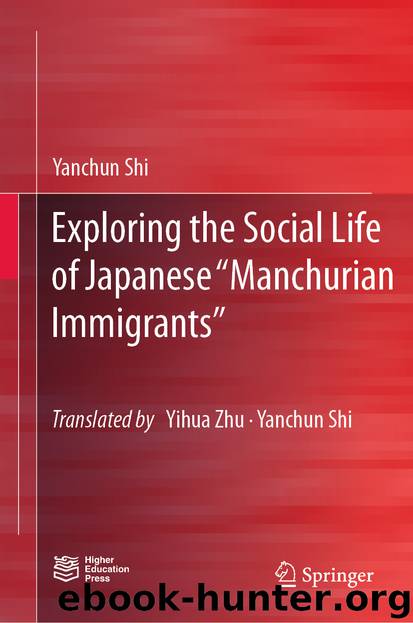Exploring the Social Life of Japanese “Manchurian Immigrants” by Yanchun Shi

Author:Yanchun Shi
Language: eng
Format: epub
ISBN: 9789811520853
Publisher: Springer Singapore
3.2 Daily Agricultural Operations of the “Manchurian Immigrants”
3.2.1 Modes of Agricultural Operations of the “Manchurian Immigrants”
After Japanese agricultural immigrants came to Northeast China, they were to solve their survival problems first in order to live for a long time. They adopted the indigenous mode of farming in Northeast China, that is, the plow-type farming method based on animal power for farming. In this regard, the Japanese peasant writer Kensaku Shimaki mentioned in his A Journey to Manchuria that “the farming method adopted by the pioneering colonizers is still the original Manchurian farming method,” “I am not holding fantasy to go there, but the situation of not using new agricultural machinery still surprises me. What are still in use for farming includes plows, wood rollers, sowing gourds, hoes, sickles and stone rollers.”25 The conventional mode of farming in Manchuria requires relatively more manpower, and the difference in labor distribution between the busy and slack farming seasons is large, as the labor intensity during the busy period is very high. Over time, the area cultivated by immigrants had also been expanded, and the “Manchurian immigrants” hired a large amount of local labor to cultivate. In order to alleviate the labor pressure during the busy and slack seasons, and replace the manpower with animal power or machinery, the emigration authorities strongly advocated the transformation from the inherent plow-type mode of farming to the western-style plow mode of farming, which was generally referred to as the “improved mode of farming.”
From February to March 1938, in order to improve the farming methods of immigrants, the Japanese government organized the secretary-generals of farmers’ associations in the prefectures of Japan to inspect the immigration areas in Northeast China. After their inspection, Kenji Komori, Secretary-General and Technician of Hokkaido Farmers’ Association, advocated using the improved mode of farming in Hokkaido. Since then, the Hokkaido agricultural expert Shotaro Mitani had been commissioned by the Manchuria Committee of Colonial Affairs and the Rural Renewal Association to conduct another investigation to the immigration areas. Mitani strongly criticized the plow-type mode of farming, emphasizing that the future immigrants could only be stabilized and develop if they adopted the mode of farming in Hokkaido. In July 1938, Professor Tsutou Matsuno of Fengtian (Mukden) Agricultural University visited the first and second immigration groups and expressed the same opinion. In his article entitled “The new mission of Hokkaido agriculture to the colonization of North Manchuria,” he advocated “the application of agricultural technology of the ‘Manchurian immigrants’ to make Manchurian agriculture strong enough to attract the immigrants to settle down on the Mainland of China and engage in agricultural operations.”26
Therefore, the relevant authorities launched a heated discussion on whether it was appropriate for the Hokkaido mode of farming to be applied in the immigration areas, but no consensus was reached. Finally, it was decided that the agricultural immigrants were recruited from Hokkaido to Northeast China to prove whether it was feasible. The reason why peasants were recruited from Hokkaido is because the climate and environment of Hokkaido are similar to those in Northeast China.
Download
This site does not store any files on its server. We only index and link to content provided by other sites. Please contact the content providers to delete copyright contents if any and email us, we'll remove relevant links or contents immediately.
| Anthropology | Archaeology |
| Philosophy | Politics & Government |
| Social Sciences | Sociology |
| Women's Studies |
Cecilia; Or, Memoirs of an Heiress — Volume 1 by Fanny Burney(32093)
Cecilia; Or, Memoirs of an Heiress — Volume 3 by Fanny Burney(31481)
Cecilia; Or, Memoirs of an Heiress — Volume 2 by Fanny Burney(31435)
The Great Music City by Andrea Baker(30932)
We're Going to Need More Wine by Gabrielle Union(18664)
All the Missing Girls by Megan Miranda(14858)
Pimp by Iceberg Slim(13828)
Bombshells: Glamour Girls of a Lifetime by Sullivan Steve(13718)
Fifty Shades Freed by E L James(12937)
Talking to Strangers by Malcolm Gladwell(12916)
Norse Mythology by Gaiman Neil(12880)
For the Love of Europe by Rick Steves(11677)
Crazy Rich Asians by Kevin Kwan(8912)
Mindhunter: Inside the FBI's Elite Serial Crime Unit by John E. Douglas & Mark Olshaker(8751)
The Lost Art of Listening by Michael P. Nichols(7190)
Enlightenment Now: The Case for Reason, Science, Humanism, and Progress by Steven Pinker(6891)
The Four Agreements by Don Miguel Ruiz(6343)
Bad Blood by John Carreyrou(6295)
Weapons of Math Destruction by Cathy O'Neil(5873)
